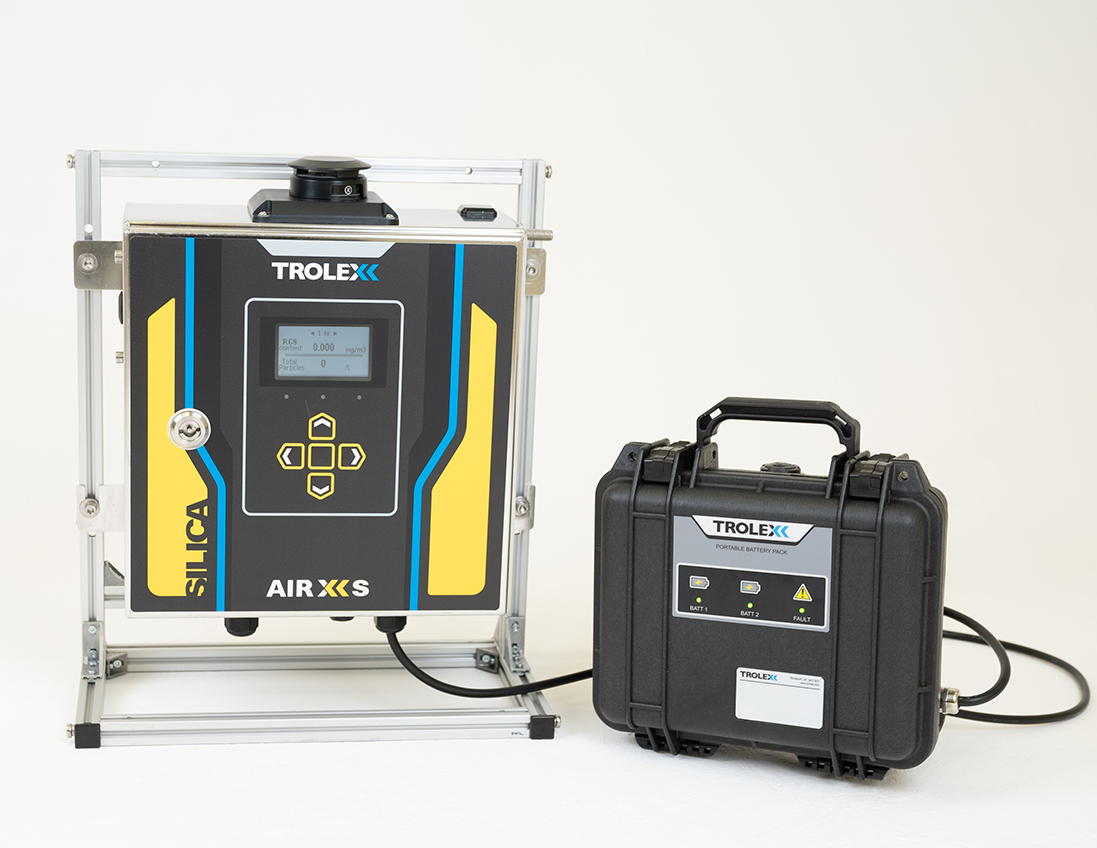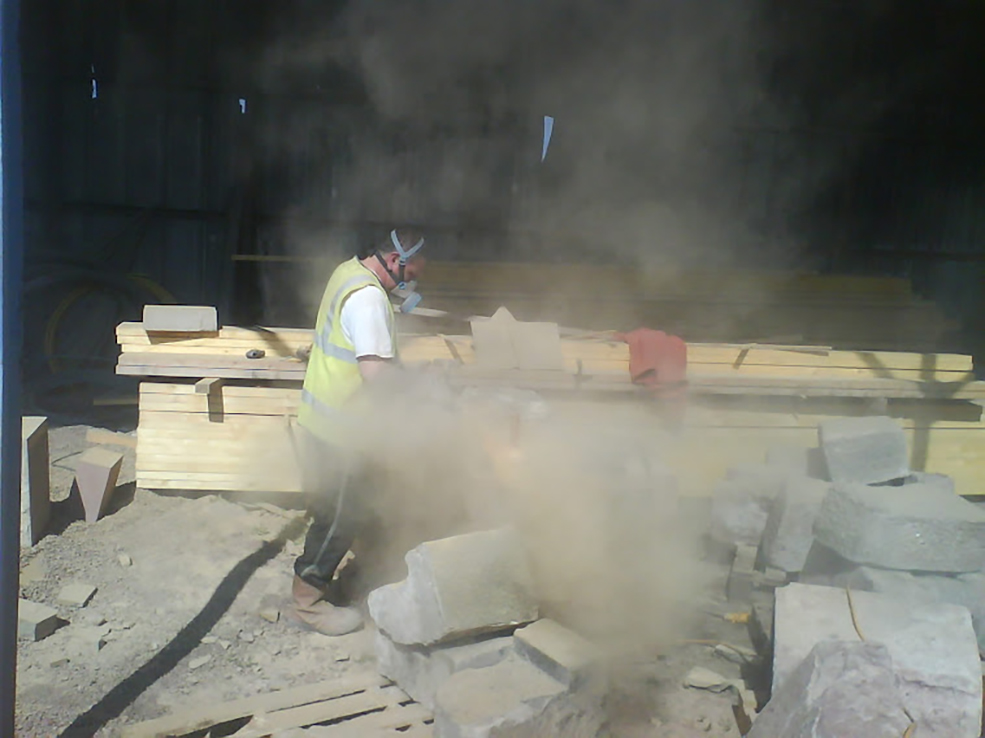Stonemason housebound by diseases from dust blames ignorance

Gordon Somerville started working in construction at the age of 15 and spent his life as a builder and stonemason, eventually running his own masonry company. Today he is 61 and housebound, a victim of exposure to respirable crystalline silica dust.
The extent of the damage the dust had caused him became apparent in 2014, when he collapsed on the scaffold at work.
Following tests, the true severity of the damage years of dust exposure had caused became clear. He was suffering from various systemic diseases.
The first signs that there was anything wrong came in the early 1990s when he had to have his dust-blocked sinuses scraped. He says: “This was the first time I was informed abnormalities had shown up in my lung X-rays.”
He was also suffering from the effects of exposure to vibration as a result of using power tools and in 2000 had operations for carpal and cubital tunnel syndrome and was diagnosed with hand arm vibration syndrome (HAVS). “Despite all this, I still felt reasonably fit,” he says.
His collapse on the scaffold in 2014 graphically illustrated that he was not as fit as he thought he was and in 2015 he was diagnosed with life threatening diseases linked to his exposure to respirable crystalline silica (RCS), dust produced when high silica content stone such as sandstone, slate and granite, as well as engineered quartz and concrete, are cut.
In order to highlight the dangers of working with RCS and to improve awareness and education, Gordon agreed to talk to Trolex, the British manufacturer of health & safety products that last year launched the Air XS Silica Monitor, which uses lasers to provide instant measurements of the level of RCS in the air. Trolex claim it is the first detector to be able to do this.
Gordon Somerville told Trolex: “I am a stonemason and builder by trade and began working in the construction industry when I left school in 1976. No matter what type of work I was carrying out or who I was working for, daily dust was involved and lots of it. I didn’t realise dust was making me ill but during my career there were clues which should have raised a red flag."
Trolex asked him: What would your reaction have been if you’d had an Air XS device on your site, telling you that you were exposed to excessive levels of RCS? Would this knowledge have made any difference to your work life?
Gordon Somerville: “A measurement device in any enclosed environment, such as a banker shed or a stone cutting yard, is a perfect example of where monitoring equipment could prevent so many illnesses by providing real time air quality information.”
Gordon says he, like many workers, was told that working in the open air was safe because the dust would be removed by the breeze, so they believed they did not need masks or dust extraction systems. “During the ’80s and ’90s dust was only considered a nuisance, almost no-one wore a respirator,” says Gordon.
The Health & Safety Executive (HSE) estimates there are as many as 600,000 workers a year exposed to silica in the UK and some 12,000 deaths resulting from lung diseases linked to past exposures of all kinds at work. Silica illness from RCS is said to be second only to asbestos. However, in 2013 the UK government removed silicosis from the list of notifiable diseases under RIDDOR (Reporting of Injuries, Diseases & Dangerous Occurrences Regulations), making it hard to track and assess the actual extent of the problem nationally and more difficult to link a case to an employer.
If an employer’s negligence can be shown to have resulted in a case of silicosis the sufferer is entitled to claim compensation, which can be a considerable sum.
As Gordon says: “The major cause of many occupational diseases is ignorance – a lack of awareness or basic information. I would suggest that not knowing how much dust is in the air at any given moment in time is a serious lack of essential information and any enclosed area where dust is created should be monitored and recorded by law.”
Trolex: If you could change anything about the approach and attitudes you and others had towards particulate safety, what would it be? For example, what measures in dust reduction would you like to see introduced?
Gordon: “I think education on all matters concerning dust is very important and there should be a requirement for any employee on entering a dusty occupation to know the dangers.
“To this day there is a severe lack of awareness of the dangers of dust and the diseases it can cause, not only throughout the workforce but also within the medical profession. In my experience, many GPs have never heard of half the diseases dust can cause, never mind of their connection with dust exposure.
“If the workforce understands the danger, knows what they are protecting themselves and others against and understand the reasons for complying with dust controls, then there is a much greater probability that they will at least attempt to reduce their dust production. The unaware cannot protect themselves from the unknown.”
Trolex: What is your life like now, and how much has silicosis affected you?
Gordon: “If you let dust get anywhere into your body it can cause all kinds of totally unexpected chaos. I can assure you, no-one ever mentioned any of this to me. I was always a very fit and active person and was rarely found inside the house. Today, I’m housebound.
“But it’s the pain that’s worst of all, something that I suffer from constantly and all over. Dusty diseases do not usually come in ones, as they are systemic diseases. If you only end up suffering from one, you can consider yourself lucky.
“There are lots of conditions no-one ever mentioned were associated with exposure to crystalline silica dust. I was recently diagnosed with liver disease, as well as dust causing inflammation in my brain…
“All the diseases currently affecting me were 100% preventable.
“The only cure for dusty diseases at the moment is not to let dust get inside the body, which means in order for silica induced diseases to be classed as 100% preventable, awareness of the hazard throughout the exposed population is required.
“Unfortunately, most of this information is not generally available to the exposed workforce. The warnings about RCS should include all the diseases associated with exposure to RCS dust; all the diseases that seem to be ignored and are classed as rare but seem to be rather common among dusty workers.
“I believe silicosis should be returned to the reportable diseases list along with the addition of all the other diseases known to be associated with dust. No-one knows how many workers actually get sick in this country as figures for these diseases are only guesstimated. Many are not even included.
“Apart from making the population aware of all the dangers associated with dust and teaching the workforce how to safely suppress and control emissions, the only other options are to ban dust production completely or go down the lines of other countries and restrict all work that produces dust to trained licence holders.
“I would suggest education is simpler.”
Trolex: Silica is the biggest risk to construction workers after asbestos from the inhalation of dust particulates in the workplace. Yet silicosis is entirely preventable and the Air XS Silica Monitor is set to revolutionise worker safety within the construction industry by delivering real-time detection of dangerous respirable crystalline silica (RCS) particulates in airborne dust mixtures on the job.
The Air XS Silica Monitor can distinguish the presence of RCS within dust mixtures and displays the presence of RCS mass by volume. In addition, the Air XS Silica Monitor can track changing concentrations of RCS content over time, letting workers know if the amount of RCS in their workspace is increasing as they work and when it has risen to dangerous levels.
Glyn Pierce-Jones, Trolex CEO, says: “This is an exciting product in real time silica dust monitoring. The Air XS is a global-leading solution to an increasing health problem in many industries. Real time silica monitoring is the safest and most cost-effective way to promote workers’ health in the industries associated with RCS.
“The Air XS will substantially reduce the number of surveys needed onsite, improve processes, create smart ventilation and extraction systems and identify inefficiencies.”

The Trolex Air XS real-time RCS monitor that won five product innovation awards last year, when it was launched. Stonemason Gordon Somerville, debilitated by diseases caused by dust, talks to Trolex about how the company's monitor can help protect people who can be exposed to respirable crystalline silica dust.

